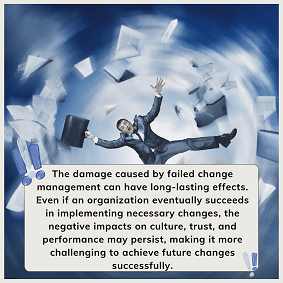The ability to manage change effectively is a vital skill. Whether you’re an organizational leader, a project manager, or an individual contributor, change management plays a pivotal role in ensuring the successful implementation of new initiatives. However, despite its importance, many change management efforts still falter. In this article, we’ll explore the common pitfalls you should avoid when managing change, ultimately ensuring a smoother transition for your organization.
 1. Ignoring Stakeholder Involvement
1. Ignoring Stakeholder Involvement
One of the most significant mistakes in change management is neglecting the involvement of key stakeholders. Effective change requires buy-in and participation from employees at all levels of the organization. Failing to engage them in the process can lead to resistance and ultimately hinder the success of your change initiative. Make an effort to listen to their concerns, provide clear communication, and involve them in decision-making where possible.
2. Lack of Clear Communication
Communication is the backbone of successful change management. Failing to provide clear and consistent messages about the change can create confusion and mistrust. Ensure that your communication strategy is well-planned, and that you address the “what, why, and how” of the change. Regular updates and opportunities for feedback will help keep everyone informed and engaged.
3. Overlooking Resistance
Change often faces resistance, and ignoring or dismissing it can be detrimental. Recognize that resistance is a natural part of the change process and take proactive steps to address it. Listen to concerns, provide support, and offer opportunities for training and skill development to help employees adapt to the new way of doing things.
4. Neglecting the Human Element
Change is not just about processes and systems; it also involves people. Focusing solely on the technical aspects of change while overlooking the emotional and psychological impact on employees is a common mistake. Empathy, coaching, and emotional support should be integral parts of your change management strategy.
5. Rushing the Process
Change management is not a sprint; it’s a marathon. Rushing the process can lead to inadequate preparation and increased resistance. Allocate enough time for planning, execution, and follow-up. Be patient and flexible, allowing time for employees to adjust to the new normal.
6. Inadequate Training and Education
Implementing change without providing adequate training and education is a recipe for disaster. Employees must have the knowledge and skills required to operate in the new environment. Ensure that training is well-structured, easily accessible, and ongoing.
Managing change effectively is a complex and multi-faceted task. Avoiding common pitfalls, such as ignoring stakeholder involvement, failing to communicate effectively, neglecting resistance, overlooking the human element, rushing the process, and providing inadequate training, is essential for achieving successful change management.
If you want to develop your change management skills and gain expertise in guiding organizations through transformative processes, consider enrolling in the Change Management course and exam through Training Creatively.
This comprehensive program will equip you with the knowledge and tools you need to lead change initiatives with confidence. Don’t miss the opportunity to enhance your career and make a meaningful impact on your organization’s success. Contact us today to learn more and enroll in the course! Click here to get a limited offered voucher.
